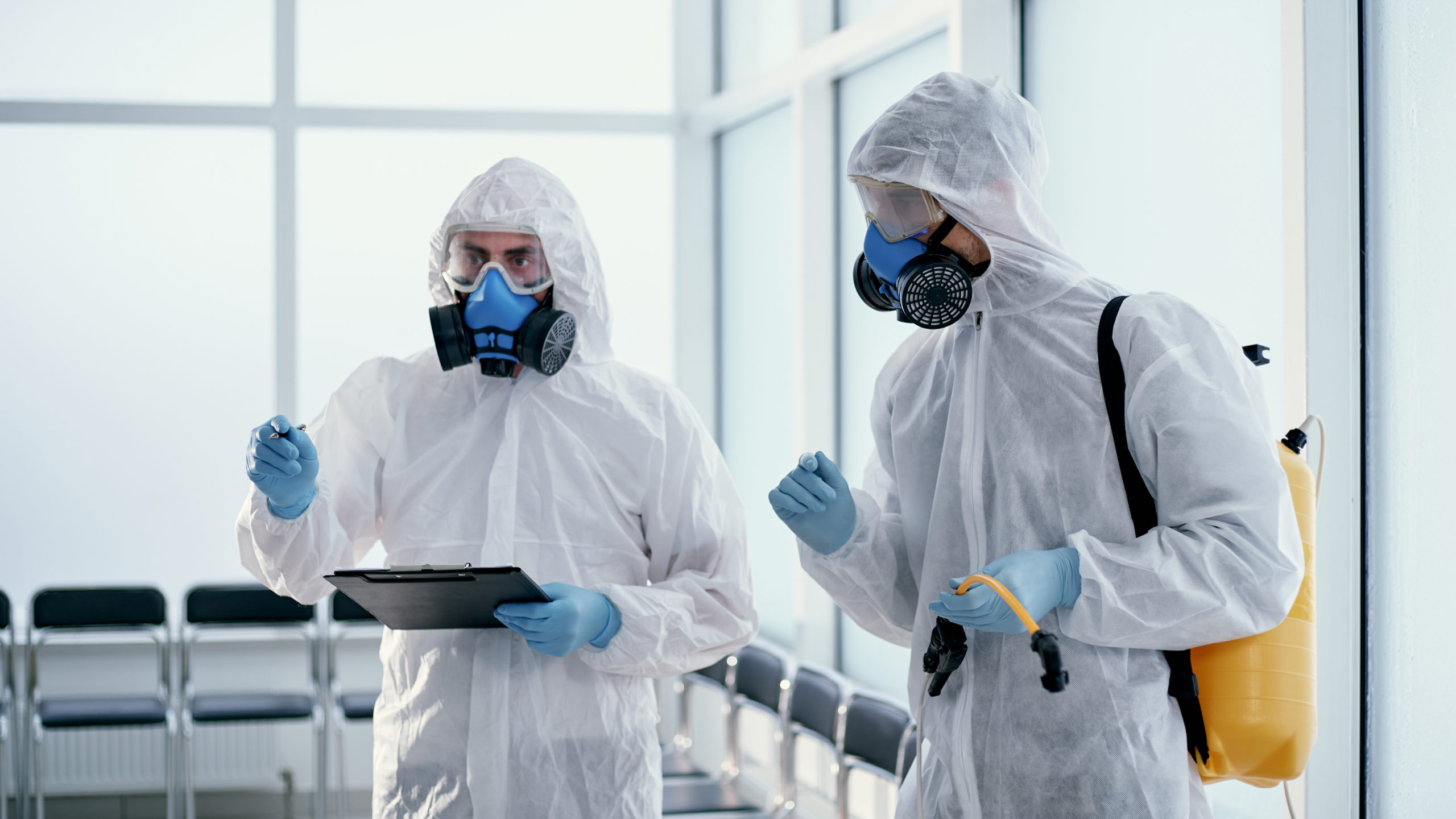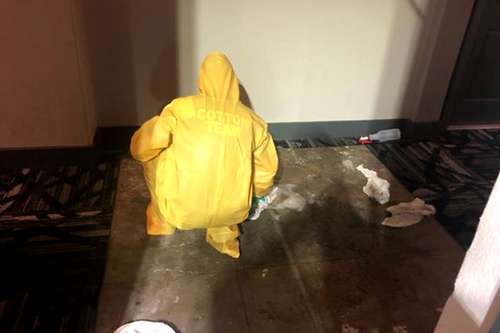Biohazard Removal: Safe Handling and Disposal of Hazardous Materials
Biohazard Removal: Safe Handling and Disposal of Hazardous Materials
Blog Article
Expert Biohazard Cleansing and Decontamination for Blood, Bodily Fluids, and Hazardous Products
In the realm of biohazard cleansing and purification for blood, physical liquids, and unsafe materials, accuracy and expertise are paramount. The possible health threats connected with exposure to biohazards highlight the vital need for meticulous handling and complete clean-up. Specialized training gears up specialists with the knowledge and abilities necessary to attend to these harmful circumstances effectively. However, it is not just regarding cleaning up; the value of utilizing correct decontamination techniques can not be overemphasized. As we browse the intricate landscape of biohazard cleaning, comprehending the subtleties of laws, compliance, and the specific devices at play becomes critical in ensuring a secure and detailed decontamination process.
Health And Wellness Dangers of Biohazard Exposure
Exposure to biohazards presents substantial health and wellness dangers that can result in severe repercussions for neighborhoods and individuals alike. Biohazards include a wide variety of organic materials, consisting of blood, bodily liquids, mold and mildew, bacteria, viruses, and other potentially transmittable products. When people enter contact with these biohazards, whether through crashes, improper handling, or ecological direct exposure, they deal with the danger of having major illnesses or diseases.
One of the key wellness threats linked with biohazard direct exposure is the transmission of infectious conditions. Bloodborne microorganisms such as HIV, hepatitis B and C, and different bacteria can be existing in biohazardous materials, positioning a straight risk to human wellness. Inhaling airborne biohazards like mold spores or entering into contact with polluted surface areas can likewise lead to respiratory system problems, allergies, and other unfavorable health and wellness effects.
Furthermore, biohazard exposure can have long-lasting health and wellness ramifications, with some conditions showing up years after the initial call (Blood Cleanup). As a result, it is vital to focus on appropriate biohazard cleaning and decontamination to mitigate these health threats and make certain the safety and security of people and communities

Specialized Educating for Biohazard Cleaning
When it pertains to taking care of biohazard cleaning successfully and securely, specialized training plays a basic function in ensuring proper purification procedures are followed. Biohazard cleanup needs details expertise and skills to efficiently mitigate threats linked with bloodborne pathogens, physical fluids, and unsafe materials. Experts trained in biohazard cleaning undertake rigorous guideline on exactly how to safely handle, eliminate, and get rid of biohazardous products to prevent contamination and direct exposure.
Specialized training for biohazard clean-up covers a variety of crucial subjects, including proper individual protective devices (PPE) usage, bloodborne virus recognition, purification strategies, and hazardous waste disposal methods. People learnt biohazard cleaning are geared up with the essential knowledge to examine contamination levels, identify prospective threats, and apply appropriate clean-up treatments in conformity with regulatory requirements.
Continuous training and education are paramount in the field of biohazard cleaning to stay upgraded on the most recent purification modern technologies, crime scene cleanup videos security procedures, and regulations. By investing in specialized training, biohazard clean-up professionals can effectively reply to emergency clean-up situations and guard both public wellness and the environment.
Significance of Appropriate Purification Strategies
Utilizing proper purification strategies is vital in biohazard cleanup to successfully reduce and eliminate dangerous materials health and wellness risks. Efficient purification not only makes sure the elimination of visible traces of blood, bodily liquids, and various other biohazards but also targets invisible virus that may present major health hazards if not correctly removed. By following rigid decontamination procedures, trained specialists can substantially minimize the threat of exposure to harmful microorganisms, infections, and microorganisms that could lead to illness or infections.
Appropriate decontamination strategies include the usage of specialized equipment and disinfectants that are particularly made to neutralize biohazards effectively. Extensive cleansing and sanitation of polluted areas are necessary to prevent the spread of virus and make certain a secure environment for passengers. In addition, the proper disposal of biohazardous waste complying with decontamination treatments is important in preventing contamination of various other surface areas or individuals.

Tools and Devices for Safe Cleanup
When dealing with blood, bodily liquids, or hazardous materials, biohazard cleansing specialists count on specialized gear to reduce direct exposure risks and thoroughly decontaminate the afflicted area. Additionally, biohazard cleaning packages consisting of disinfectants, absorbent materials, and biohazard bags are used to securely dispose and contain of polluted things.
Advanced cleaning tools like hospital-grade anti-bacterials, HEPA-filtered vacuums, and misting devices are used to sanitize surface areas and get rid of biohazards successfully. Specialized equipment such as sharps containers and biohazard garbage disposal bins are utilized to securely take care of sharp items and biohazardous waste products. By utilizing the right tools and devices, biohazard cleaning experts can make sure a comprehensive cleanup process that prioritizes safety and security and minimizes health threats for both workers and occupants of the afflicted room.
Laws and Compliance in Biohazard Cleansing
Correct adherence to policies and conformity criteria is critical in biohazard cleansing to make certain the security of both personnel and the atmosphere. Government firms such as OSHA (Occupational Safety and how do you clean up blood from carpet Wellness Administration) and the EPA (Epa) have actually established specific guidelines for biohazard cleanup procedures to decrease health and wellness threats and environmental contamination. These regulations cover a series of facets consisting of the handling, transportation, and disposal of biohazardous materials, along with the essential training and safety tools required for workers associated with the cleaning process.
Biohazard cleansing business should remain up-to-date with these policies to assure that their procedures meet the needed safety criteria. Failing to abide by these guidelines can result in serious effects, consisting of penalties, lawsuit, and jeopardizing the health of individuals and the atmosphere. By following rigid policies and conformity procedures, biohazard cleansing business can properly mitigate dangers and make certain a secure and complete clean-up process for all celebrations included.
Conclusion
Finally, biohazard cleaning and purification need customized training, proper techniques, and adherence to regulations. Direct exposure to blood, bodily liquids, and hazardous products poses substantial health threats, making it crucial to use the right equipment and tools for risk-free cleaning. By complying with rigorous procedures and standards, specialists can successfully mitigate the risks connected with biohazard exposure and guarantee the security of both themselves and others.
As we browse the elaborate landscape of biohazard cleanup, recognizing the subtleties of guidelines, compliance, and the specialized tools at play ends up being essential in making certain a risk-free and extensive purification procedure. (Blood Cleanup)
When it comes to handling biohazard cleanup effectively and safely, specialized training plays a fundamental function in making sure appropriate decontamination procedures are complied with.Using appropriate purification techniques is essential in biohazard cleaning to properly lessen and eliminate unsafe materials health and wellness dangers. In addition, biohazard cleansing packages containing anti-bacterials, absorbing products, and biohazard bags are used to safely continue reading this get rid of and contain of polluted items.
Government firms such as OSHA (Occupational Safety And Security and Wellness Management) and the EPA (Environmental Protection Firm) have established specific standards for biohazard clean-up treatments to reduce wellness dangers and environmental contamination.
Report this page